Trends in Emissions from Road Traffic in Rapidly Urbanizing Areas
Abstract
:1. Introduction
2. Literature Review
2.1. Emission Inventory Research
2.2. Spatiotemporal Characteristics
2.3. Influencing Factors
3. Materials and Methods
3.1. Research Area
3.2. Vehicle Fleet Profile of Research Area
3.3. Vehicle Emissions Estimation
- (1)
- Number of vehicles
- (2)
- Vehicle emission factors
- (3)
- Annual kilometers traveled (VKT)
3.4. Vehicle Emissions’ Spatial Differentiation Methods
3.4.1. Calculation of the Standard Road Length
3.4.2. Calculation of the Standard Road Emission Intensity
3.4.3. Calculation of Grid Emissions
4. Results and Discussion
4.1. Spatiotemporal Characteristics
4.2. Factors Influencing Analysis
- (1)
- Implications of natural conditions
- (2)
- Implications of existing policies
4.3. Comparison with Other Studies
5. Conclusions and Policy Implications
5.1. Conclusions
5.2. Policy Implications
- (1)
- The government has prioritized controlling pollutants but has not taken significant action to reduce CO2 emissions, resulting in an overall increase in CO2 levels. Therefore, policy-makers should formulate specific measures to target CO2 emissions from vehicles, refrain from the usage of high-emission vehicles, and provide subsidies for the acquisition of new clean-energy vehicles. In addition to vehicle control, governments should implement measures to expand the coverage area of green plants.
- (2)
- Significant CO2 and pollutants emissions in trunk roads are attributed to the expansion of roads and road networks. Trunk roads provide faster channels for vehicles and attract more traffic flow, resulting in remarkable emissions. Therefore, policy-makers should limit traffic flow on trunk roads and prohibit vehicles powered by highly polluting fuels. Moreover, more roads should be developed to provide more options in residential areas, thereby relieving the emission pressure on trunk roads.
- (3)
- Emissions from vehicles have expanded from the lower elevations of the city to higher regions, showing a significant trend of urban expansion. Therefore, policy-makers should concentrate on urban migration, land utilization, and road expansion, as well as on slowing down urban expansion and protecting areas that are not contaminated currently.
Author Contributions
Funding
Institutional Review Board Statement
Informed Consent Statement
Data Availability Statement
Acknowledgments
Conflicts of Interest
References
- Santos, R.M.; Bakhshoodeh, R. Climate change/global warming/climate emergency versus general climate research: Comparative bibliometric trends of publications. Heliyon 2021, 7, e8219. [Google Scholar]
- Mentaschi, L.; Duveiller, G.; Zulian, G.; Corbane, C.; Pesaresi, M.; Maes, J.; Stocchino, A.; Luc, F. Global long-term mapping of surface temperature shows intensified intra-city urban heat island extremes. Glob. Environ. Chang. 2022, 72, 102441. [Google Scholar]
- Min, R.; Gu, X.; Guan, Y.; Zhang, X. Increasing likelihood of global compound hot-dry extremes from temperature and runoff during the past 120 years. J. Hydrol. 2023, 621, 129553. [Google Scholar]
- Naď, M.; Brummer, V.; Lošák, P.; Máša, V.; Sukačová, K.; Tatarová, D.; Pernica, M.; Procházková, M. Waste-to-energy plants flue gas CO2 mitigation using a novel tubular photobioreactor while producing Chlorella algae. J. Clean. Prod. 2023, 385, 135721. [Google Scholar]
- Tian, C.; Yue, X.; Zhu, J.; Liao, H.; Yang, Y.; Chen, L.; Zhou, X.; Lei, Y.; Zhou, H.; Cao, Y. Projections of fire emissions and the consequent impacts on air quality under 1.5 °C and 2 °C global warming. Environ. Pollut. 2023, 323, 121311. [Google Scholar] [PubMed]
- Miao, L.; Tang, S.; Li, X.; Yu, D.; Deng, Y.; Hang, T.; Yang, H.; Liang, Y.; Kwan, M.; Huang, L. Estimating the CO2 emissions of Chinese cities from 2011 to 2020 based on SPNN-GNNWR. Environ. Res. 2023, 218, 115060. [Google Scholar]
- Zhang, L.; Weng, D.; Xu, Y.; Hong, B.; Wang, S.; Hu, X.; Zhang, Y.; Wang, Z. Spatio-temporal evolution characteristics of carbon emissions from road transportation in the mainland of China from 2006 to 2021. Sci. Total Environ. 2024, 917, 170430. [Google Scholar]
- Li, X.; Yu, B. Peaking CO2 emissions for China’s urban passenger transport sector. Energy Policy 2019, 133, 110913. [Google Scholar]
- Yu, C.; Long, H.; Zhang, X.; Tan, Y.; Zhou, Y.; Zang, C.; Tu, C. The interaction effect between public environmental concern and air pollution: Evidence from China. J. Clean. Prod. 2023, 391, 136231. [Google Scholar]
- Hao, Y.; Gai, Z.; Yan, G.; Yan, G.; Wu, H.; Irfan, M. The spatial spillover effect and nonlinear relationship analysis between environmental decentralization, government corruption and air pollution: Evidence from China. Sci. Total Environ. 2021, 763, 144183. [Google Scholar]
- Shen, Y.; Zhang, X. Intelligent manufacturing, green technological innovation and environmental pollution. J. Innov. Knowl. 2023, 8, 100384. [Google Scholar]
- Zhao, N.; Elshareef, H.; Li, B.; Wang, B.; Jia, Z.; Zhou, L.; Liu, Y.; Sultan, M.; Dong, R.; Zhou, Y. The efforts of China to combat air pollution during the period of 2015–2018: A case study assessing the environmental, health and economic benefits in the Beijing-Tianjin-Hebei and surrounding “2 + 26” regions. Sci. Total Environ. 2022, 853, 158437. [Google Scholar] [PubMed]
- Seaton, M.; O’Neill, J.; Bien, B.; Hood, C.; Jackson, M.; Jackson, R.; Johnson, K.; Oades, M.; Stidworthy, A.; Stocker, J.; et al. A Multi-model Air Quality System for Health Research: Road model development and evaluation. Environ. Model. Softw. 2022, 155, 105455. [Google Scholar]
- Liu, X.; Wang, Y.; Zhu, R.; Wei, Y.; Hu, J. Complex temperature dependence of vehicular emissions: Evidence from a global meta-analysis. Environ. Res. 2023, 237, 116890. [Google Scholar] [PubMed]
- Luo, Y.; Zeng, W.; Hu, X.; Yang, H.; Shao, L. Coupling the driving forces of urban CO2 emission in Shanghai with logarithmic mean Divisia index method and Granger causality inference. J. Clean. Prod. 2021, 298, 126843. [Google Scholar]
- Shen, J.; Tang, P.; Zeng, H.; Cheng, J.; Liu, X. Does emission trading system reduce mining cities’ pollution emissions? A quasi-natural experiment based on Chinese prefecture-level cities. Resour. Policy 2023, 81, 103293. [Google Scholar]
- Shao, W.; Li, F.; Cao, X.; Tang, Z.; Bai, Y.; Yang, S. Reducing export-driven CO2 and PM emissions in China’s provinces: A structural decomposition and coordinated effects analysis. J. Clean. Prod. 2020, 274, 123101. [Google Scholar]
- Oreggioni, G.D.; Mahiques, O.; Monforti-Ferrario, F.; Schaaf, E.; Muntean, M.; Guizzardi, D.; Vignati, E.; Crippa, M. The impacts of technological changes and regulatory frameworks on global air pollutant emissions from the energy industry and road transport. Energy Policy 2022, 168, 113021. [Google Scholar]
- Zhu, L. Comparative evaluation of CO2 emissions from transportation in countries around the world. J. Transp. Geogr. 2023, 110, 103609. [Google Scholar]
- Liu, J.; Li, J.; Chen, Y.; Lian, S.; Zeng, J.; Geng, M.; Zheng, S.; Dong, Y.; He, Y.; Huang, P.; et al. Multi-scale urban passenger transportation CO2 emission calculation platform for smart mobility management. Appl. Energy 2023, 331, 120407. [Google Scholar]
- Zhang, L.; Lin, J.; Qiu, R. Characterizing the toxic gaseous emissions of gasoline and diesel vehicles based on a real-world on-road investigation. J. Clean. Prod. 2021, 286, 124957. [Google Scholar]
- Zhao, H.; He, H.; Lu, D.; Zhou, D.; Lu, C.; Fang, X.; Peng, Z. Evaluation of CO2 and NOx emissions from container diesel trucks using a portable emissions measurement system. Build. Environ. 2024, 252, 111266. [Google Scholar]
- Liu, K.; Lin, X.; Xu, J.; Ma, F.; Yang, W.; Cao, R.; Hu, X.; Wei, Y.; Jiang, L.; Wang, Z. Investigating the influence of platform design on the distribution of traffic particulate matter at the bus stop. Build. Environ. 2024, 255, 111395. [Google Scholar]
- Yang, J.N.; Wen, Y.F.; Wang, Y.; Seinfeld, J.H. From COVID-19 to future electrification: Assessing traffic impacts on air quality by a machine-learning model. Proc. Natl. Acad. Sci. USA 2021, 118, e2102705118. [Google Scholar]
- Duan, S.; Qiu, Z.; Liu, Z.; Liu, L. Impact assessment of vehicle electrification pathways on emissions of CO2 and air pollution in Xi’an, China. Sci. Total Environ. 2023, 893, 164856. [Google Scholar]
- Lv, Z.; Zhang, Y.; Ji, Z.; Deng, F.; Shi, M.; Li, Q.; He, M.; Xiao, L.; Huang, Y.; Liu, H.; et al. A real-time NOx emission inventory from heavy-duty vehicles based on on-board diagnostics big data with acceptable quality in China. J. Clean. Prod. 2023, 422, 138592. [Google Scholar]
- Krecl, P.; Oukawa, G.Y.; Charres, I.; Targino, A.; Grauer, A.; Silva, D. Compilation of a city-scale black carbon emission inventory: Challenges in developing countries based on a case study in Brazil. Sci. Total Environ. 2022, 839, 156332. [Google Scholar] [PubMed]
- Xu, Y.; Liu, Z.; Xue, W.; Yan, G.; Zhao, D.; Zhang, Y.; Lei, Y.; Wang, J. Identification of on-road vehicle CO2 emission pattern in China: A study based on a high-resolution emission inventory. Resour. Conserv. Recycl. 2021, 175, 105891. [Google Scholar]
- Rojas, N.Y.; Mangones, S.C.; Osses, M.; Granier, C.; Laengle, I.; Alfonso, J.V.; Mendez, J.A. Road transport exhaust emissions in Colombia. 1990–2020 trends and spatial disaggregation. Transp. Res. Part D Transp. Environ. 2023, 121, 103780. [Google Scholar]
- Zhang, B.; Yin, S.; Lu, X.; Wang, S.; Xu, Y. Development of city-scale air pollutants and greenhouse gases emission inventory and mitigation strategies assessment: A case in Zhengzhou, Central China. Urban Clim. 2023, 48, 101419. [Google Scholar]
- Das, B.; Bhave, P.V.; Puppala, S.P.; Adhikari, S.; Sainju, S.; Mool, E.; Byanju, R.M. Emission factors and emission inventory of diesel vehicles in Nepal. Sci. Total Environ. 2022, 812, 152539. [Google Scholar]
- Jiang, P.; Zhong, X.; Li, L. On-road vehicle emission inventory and its spatio-temporal variations in North China Plain. Environ. Pollut. 2020, 267, 115639. [Google Scholar]
- Huy, L.N.; Kim Oanh, N.T.; Htut, T.T.; Hlaing, O.M.T. Emission inventory for on-road traffic fleets in Greater Yangon, Myanmar. Atmos. Pollut. Res. 2020, 11, 702–713. [Google Scholar]
- Hakkim, H.; Kumar, A.; Annadate, S.; Sinha, B.; Sinha, V. RTEII: A new high-resolution (0.1° × 0.1°) road transport emission inventory for India of 74 speciated NMVOCs, CO, NOx, NH3, CH4, CO2, PM2.5 reveals massive overestimation of NOx and CO and missing nitromethane emissions by existing inventories. Atmos. Environ. X 2021, 11, 100118. [Google Scholar]
- Patiño-Aroca, M.; Parra, A.; Borge, R. On-road vehicle emission inventory and its spatial and temporal distribution in the city of Guayaquil, Ecuador. Sci. Total Environ. 2022, 848, 157664. [Google Scholar]
- Chen, S.; Du, Z.; Shi, X.; Liu, Y.; Li, S.; Shao, C.; Steve-Harold, K. MOVES-Beijing-based high spatial and temporal resolution ammonia emissions from road traffic in Beijing. Atmos. Environ. 2021, 256, 118443. [Google Scholar]
- Deng, X.; Chen, W.; Zhou, Q.; Zheng, Y.; Li, H.; Liao, S.; Biljecki, F. Exploring spatiotemporal pattern and agglomeration of road CO2 emissions in Guangdong, China. Sci. Total Environ. 2023, 871, 162134. [Google Scholar]
- Zhu, C.; Qu, X.; Qiu, M.; Zhu, C.; Wang, C.; Wang, B.; Sun, L.; Yang, N.; Yan, G.; Xu, C.; et al. High spatiotemporal resolution vehicular emission inventory in Beijing-Tianjin-Hebei and its surrounding areas (BTHSA) during 2000–2020, China. Sci. Total Environ. 2023, 873, 162389. [Google Scholar] [PubMed]
- Dai, Y.; Shi, X.; Huang, Z.; Du, W.; Cheng, J. Proposal of policies based on temporal-spatial dynamic characteristics and co-benefits of CO2 and air pollutants from vehicles in Shanghai, China. J. Environ. Manag. 2024, 351, 119736. [Google Scholar]
- Zhao, P.; Li, Z.; Xiao, Z.; Jiang, S.; He, Z.; Zhang, M. Spatiotemporal characteristics and driving factors of CO2 emissions from road freight transportation. Transp. Res. Part D Transp. Environ. 2023, 125, 103983. [Google Scholar]
- Zhou, X.; Wang, H.; Huang, Z.; Bao, Y.; Zhou, G.; Liu, Y. Identifying spatiotemporal characteristics and driving factors for road traffic CO2 emissions. Sci. Total Environ. 2022, 834, 155270. [Google Scholar]
- Wu, J.; Jia, P.; Feng, T.; Li, H.; Kuang, H.; Zhang, J. Uncovering the spatiotemporal impacts of built environment on traffic carbon emissions using multi-source big data. Land Use Policy 2023, 129, 106621. [Google Scholar]
- Shi, F.; Liao, X.; Shen, L.; Meng, C.; Lai, Y. Exploring the spatiotemporal impacts of urban form on CO2 emissions: Evidence and implications from 256 Chinese cities. Environ. Impact Assess. Rev. 2022, 96, 106850. [Google Scholar]
- Cheng, S.; Zhang, B.; Zhao, Y.; Peng, P.; Lu, F. Multiscale spatiotemporal variations of NOx emissions from heavy duty diesel trucks in the Beijing-Tianjin-Hebei region. Sci. Total Environ. 2023, 854, 158753. [Google Scholar] [PubMed]
- Cheng, S.; Zhang, B.; Peng, P.; Yang, Z.; Lu, F. Spatiotemporal evolution pattern detection for heavy-duty diesel truck emissions using trajectory mining: A case study of Tianjin, China. J. Clean. Prod. 2020, 244, 118654. [Google Scholar]
- Zhu, L.; Xiong, Q. Key influencing factor and future scenario simulation of China’s CO2 emissions from road freight transportation. Sustain. Prod. Consum. 2023, 37, 11–25. [Google Scholar]
- Pita, P.; Winyuchakrit, P.; Limmeechokchai, B. Analysis of factors affecting energy consumption and CO2 emissions in Thailand’s road passenger transport. Heliyon 2020, 6, e5112. [Google Scholar]
- Chaves GD, L.D.; Nascimento Boldrini, O.; de Alvarenga Rosa, R.; Ghisolfi, V.; Mattos Ribeiro, G. Policy influence in the dynamic of energy and carbon dioxide emissions intensity of Brazilian road transport. Case Stud. Transp. Policy 2021, 9, 1868–1878. [Google Scholar]
- Peiseler, L.; Cabrera Serrenho, A. How can current German and EU policies be improved to enhance the reduction of CO2 emissions of road transport? Revising policies on electric vehicles informed by stakeholder and technical assessments. Energy Policy 2022, 168, 113124. [Google Scholar]
- Raparthi, N.; Barudgar, A.; Chu, M.; Ning, Z.; Phuleria, H.C. Estimating individual vehicle emission factors from near-road measurements in India. Atmos. Environ. 2023, 308, 119869. [Google Scholar]
- Dong, Y.; Peng, F.; Bao, Z.; Qiao, Y. Identification of the spatial distribution pattern and driving forces of underground parking space based on multi-source data: A case study of Fuzhou City in China. Sustain. Cities Soc. 2021, 72, 103084. [Google Scholar]
- Xiao, S.; Zhang, Y.; Zhang, Z.; Song, W.; Pei, C.; Chen, D.; Wang, X. The contributions of non-methane hydrocarbon emissions by different fuel type on-road vehicles based on tests in a heavily trafficked urban tunnel. Sci. Total Environ. 2023, 873, 162432. [Google Scholar]
- Swarnkar, A.; Gurjar, B.R. GIS-based emission inventory of heavy metals from road transport and NMVOCs associated with biomass burning for megacity Delhi. Urban Clim. 2023, 51, 101600. [Google Scholar]
- Zhang, L.; Hu, X.; Qiu, R.; Lin, J. Comparison of real-world emissions of LDGVs of different vehicle emission standards on both mountainous and level roads in China. Transp. Res. Part D Transp. Environ. 2019, 69, 24–39. [Google Scholar]
- Wang, X.; Qiu, Z.; Liu, Z.; Liu, L. Real-world black carbon emissions of gasoline vehicles at urban intersections. Urban Clim. 2024, 55, 101968. [Google Scholar]
- Sun, S.; Sun, L.; Liu, G.; Zou, C.; Wang, Y.; Wu, L.; Mao, H. Developing a vehicle emission inventory with high temporal-spatial resolution in Tianjin, China. Sci. Total Environ. 2021, 776, 145873. [Google Scholar]
- Wang, H.K.; He, X.J.; Liang, X.Y.; Evans, J.S. Health benefits of on-road transportation pollution control programs in China. Proc. Natl. Acad. Sci. USA 2020, 117, 25370–25377. [Google Scholar] [PubMed]
- Wang, H.; Wu, Z.; Wu, Z.; Hou, Q. Urban network noise control based on road grade optimization considering comprehensive traffic environment benefit. J. Environ. Manag. 2024, 364, 121451. [Google Scholar]
- Gómez, C.D.; González, C.M.; Osses, M.; Aristizábal, B.H. Spatial and temporal disaggregation of the on-road vehicle emission inventory in a medium-sized Andean city. Comparison of GIS-based top-down methodologies. Atmos. Environ. 2018, 179, 142–155. [Google Scholar]
- Bucala-Hrabia, A. Reflections on land use and land cover change under different socio-economic regimes in the Polish Western Carpathians. Reg. Environ. Chang. 2024, 24, 28. [Google Scholar]
- Ru, X.; Qiao, L.; Zhang, H.; Bai, T.; Min, R.; Wang, Y.; Wang, Q.; Song, H. Effects of land use and land cover change under shared socioeconomic pathways on future climate in the Yellow River basin, China. Urban Clim. 2024, 55, 101867. [Google Scholar]
- Cavallaro, F.; Nocera, S. COVID-19 effects on transport-related air pollutants: Insights, evaluations, and policy perspectives. Transp. Rev. 2024, 44, 484–517. [Google Scholar]
- Hu, M.; Li, R.; You, W.; Liu, Y.; Lee, C. Spatiotemporal evolution of decoupling and driving forces of CO2 emissions on economic growth along the Belt and Road. J. Clean. Prod. 2020, 277, 123272. [Google Scholar]
- Li, X.; Gu, D.; Hohenberger, T.L.; Fung, Y.; Fung, J.H.; Lau, A.K.; Liang, Z. Dynamic quantification of on-road emissions in Hong Kong: Impact from traffic congestion and fleet composition variation. Atmos. Environ. 2023, 313, 120059. [Google Scholar]
- Wang, Y.; Xing, Z.; Zhang, H.; Wang, Y.; Du, K. On-road mileage-based emission factors of gaseous pollutants from bi-fuel taxi fleets in China: The influence of fuel type, vehicle speed, and accumulated mileage. Sci. Total Environ. 2022, 819, 151999. [Google Scholar]
- McCaffery, C.; Zhu, H.W.; Tang, T.B.; Li, C.G.; Karavalakis, G.; Cao, S.; Oshnuga, A.; Burnette, A.; Johnson, K.C.; Durbin, T.D. Real-world NOx emissions from heavy-duty diesel, natural gas, and diesel hybrid electric vehicles of different vocations on California roadways. Sci. Total Environ. 2021, 784, 147224. [Google Scholar] [PubMed]
- Jaiprakash; Habib, G. On-road assessment of light duty vehicles in Delhi city: Emission factors of CO, CO2 and NOx. Atmos. Environ. 2018, 174, 132–139. [Google Scholar]
- Wang, M.L.; Li, S.Y.; Zhu, R.C.; Zhang, R.; Zu, L.; Wang, Y.; Bao, X. On-road tailpipe emission characteristics and ozone formation potentials of VOCs from gasoline, diesel and liquefied petroleum gas fueled vehicles. Atmos. Environ. 2020, 223, 117294. [Google Scholar]
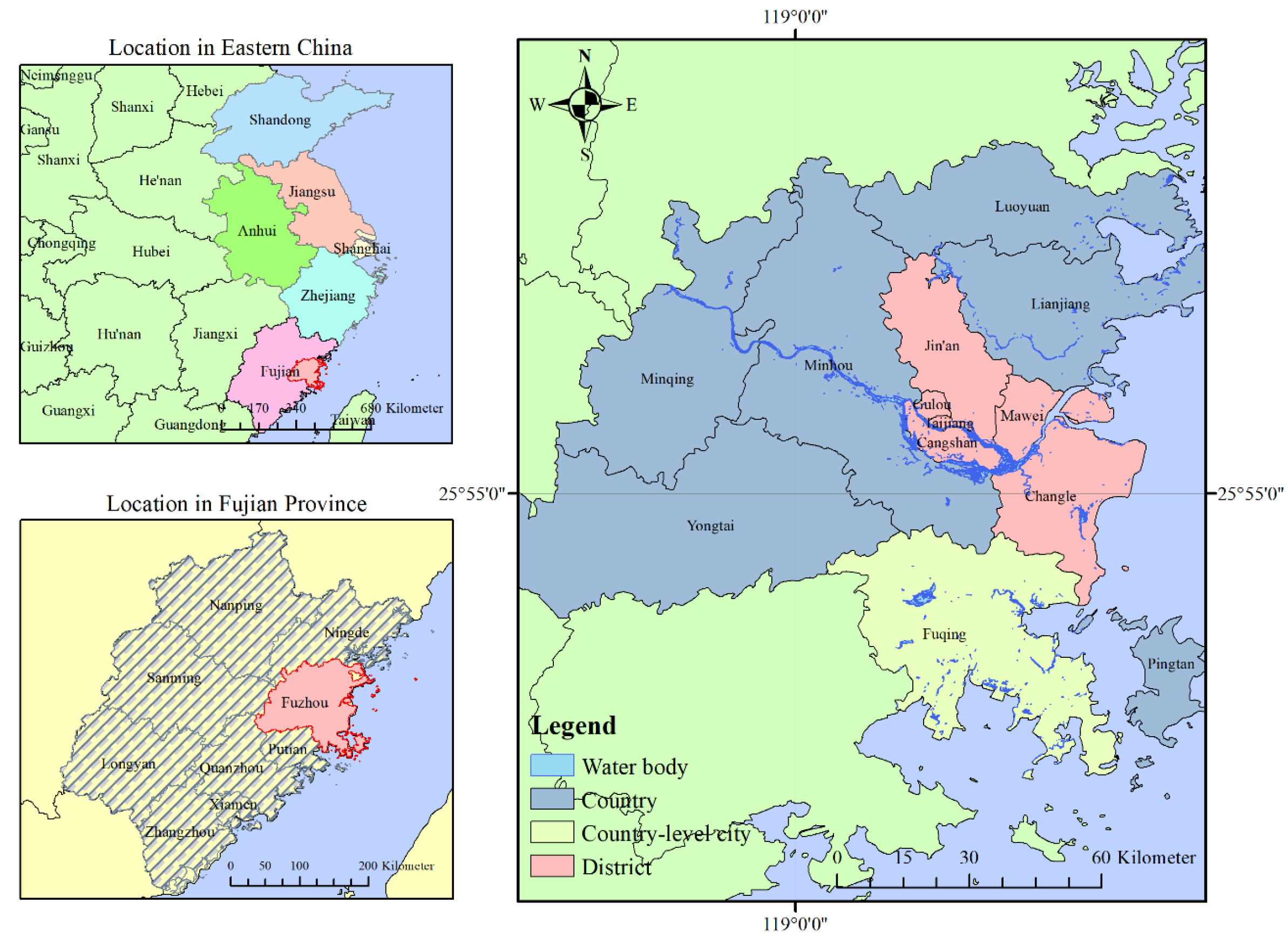
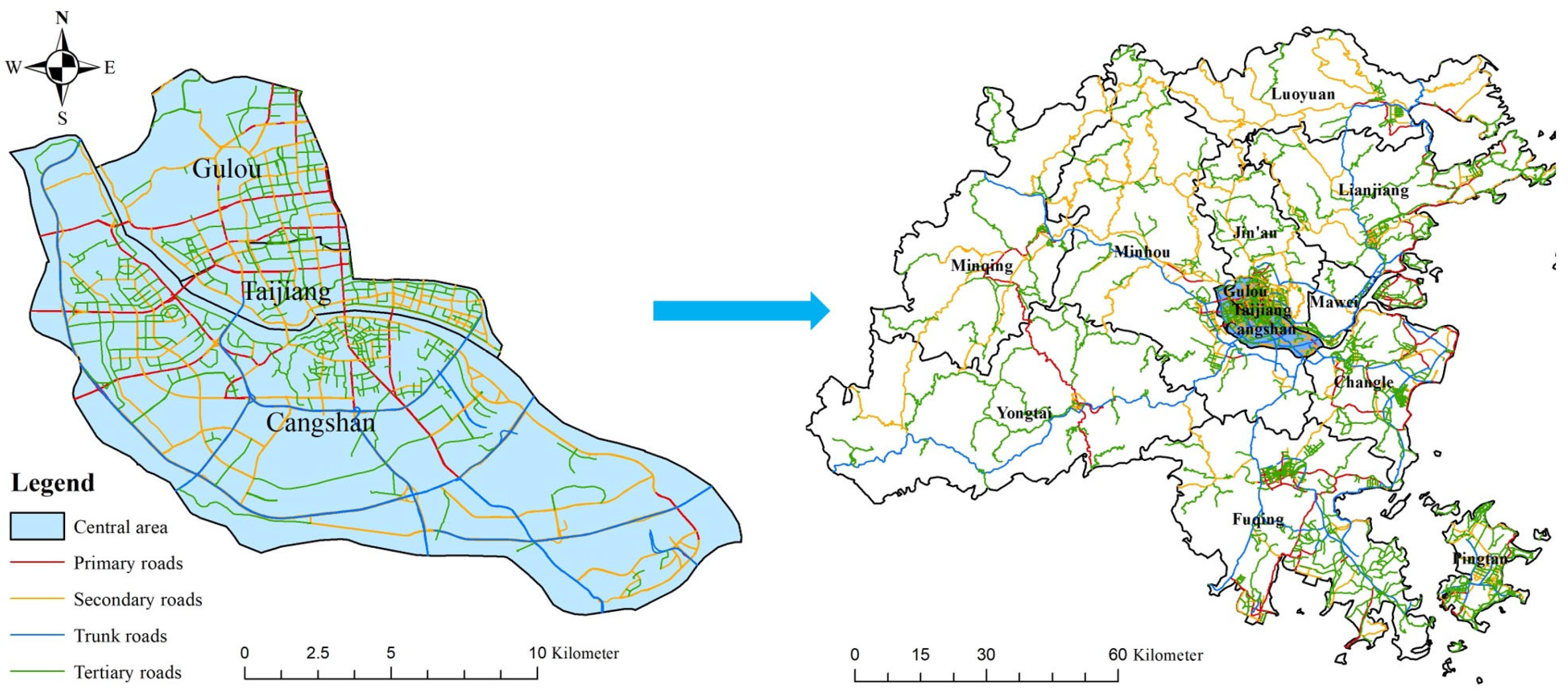
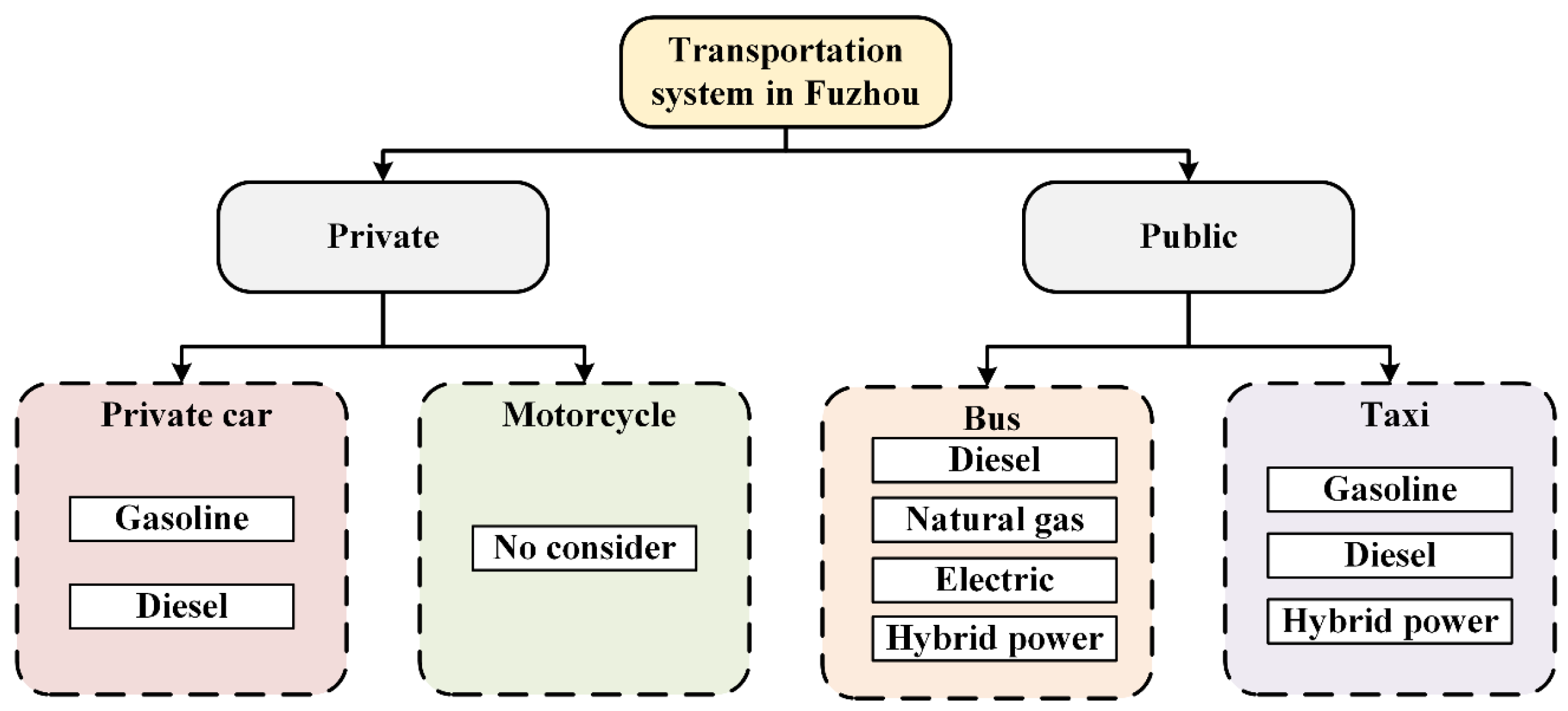





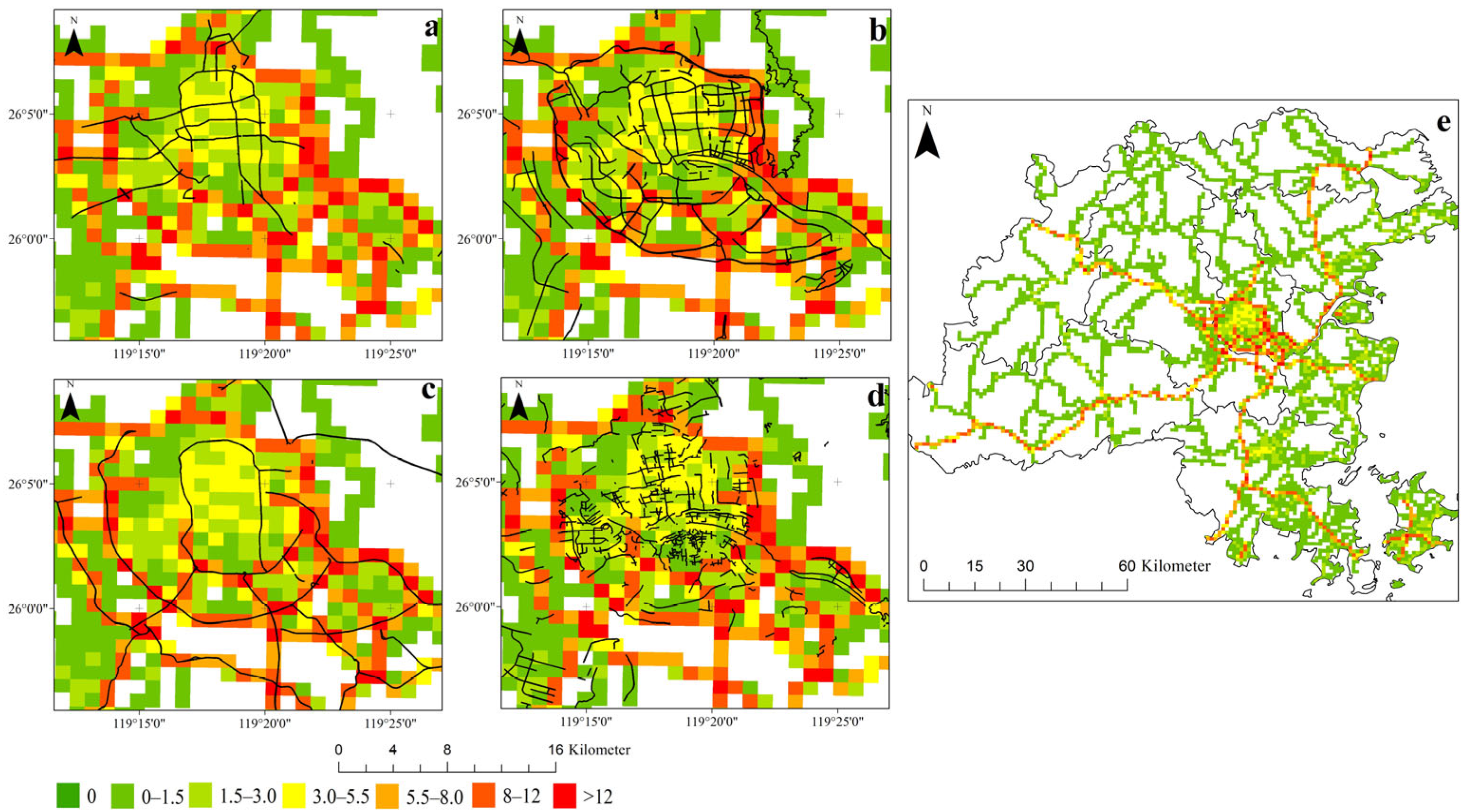


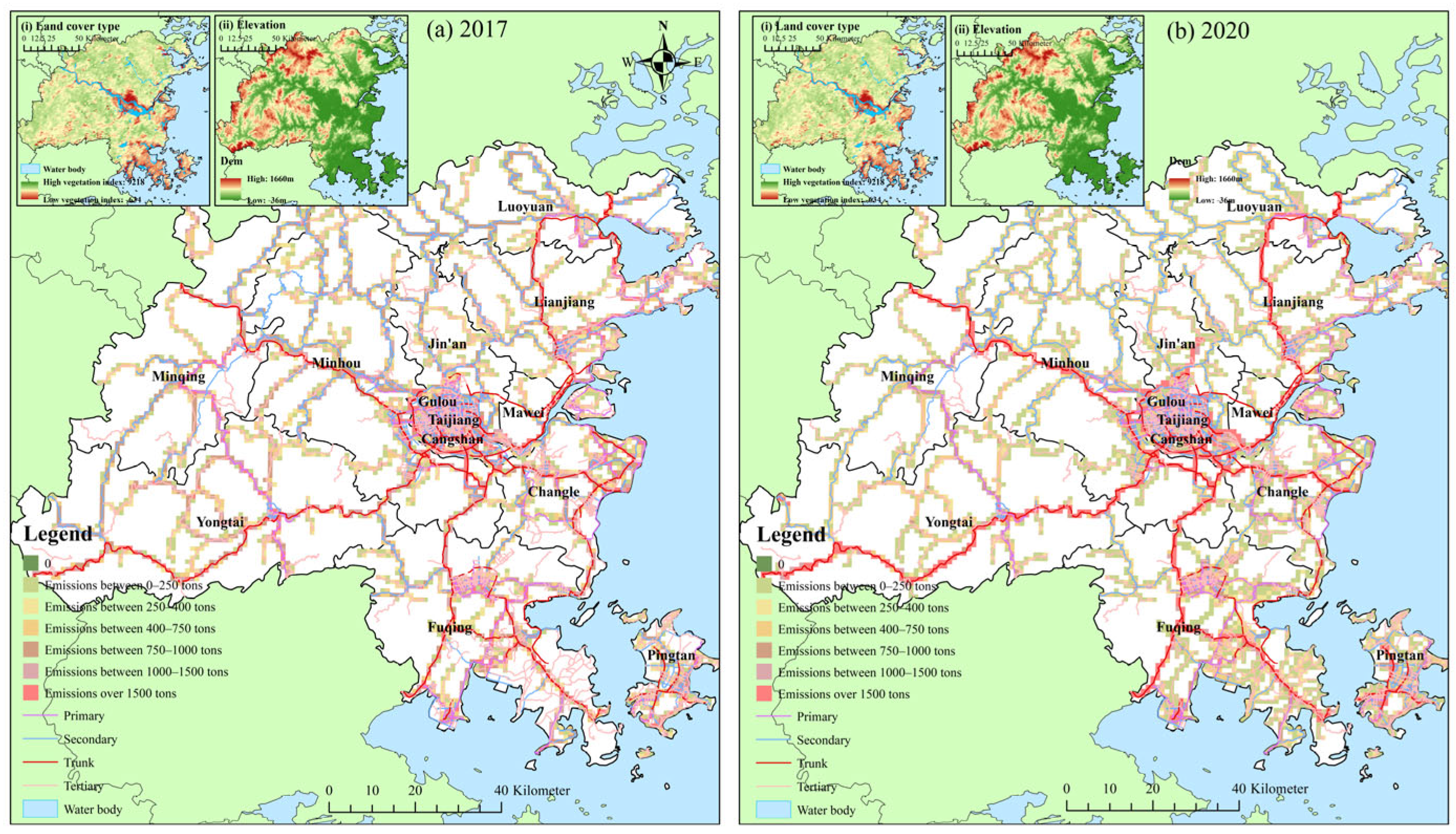
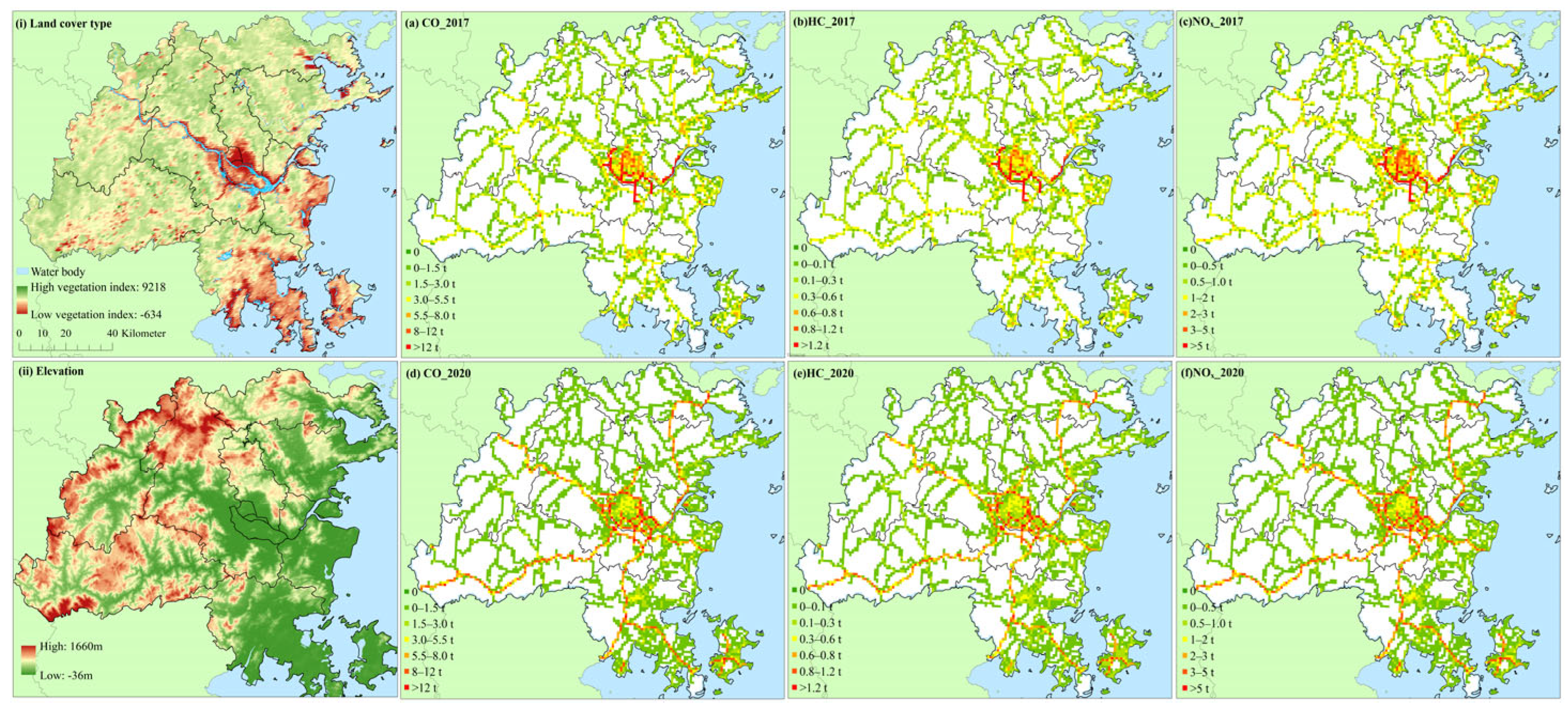
| Year | Private Car | Bus | Taxi | ||||||
|---|---|---|---|---|---|---|---|---|---|
| Fuel Type | |||||||||
| Gasoline | Diesel | Electric | Natural Gas | Diesel | Hybrid Power | Gasoline | Diesel | Hybrid Power | |
| 2017 | 825,448 | 122,253 | 1398 | 484 | 1626 | 977 | 499 | 650 | 5789 |
| 2020 | 1,038,184 | 144,258 | 3233 | 277 | 310 | 1100 | 0 | 111 | 6494 |
| Vehicle Type | Fuel Type | VKT in This Study | Statistical Data | Error Rate | Sun et al. [56] | Error Rate | Wang et al. [57] | Error Rate |
|---|---|---|---|---|---|---|---|---|
| Private car | Gasoline Diesel | 18,000 km | 18,000 km | 0% | 18,707 km | 3.9% | 16,128 km | 10.4% |
| 19,255 km | 7.0% | |||||||
| Bus | Electric Natural gas Diesel Hybrid power | 74,000 km | 60,000 km | 18.9% | 52,330 km | 29.3% | ||
| 90,202 km | 21.9% | |||||||
| Taxi | Gasoline Diesel Hybrid power | 120,000 km | 12,000 km | 0% | 107,448 km | 10.5% | 120,000 km | 0% |
| Road Grade | Road Volume (pcu/h) | Vehicle Speed (km/h) | Setting of Weight Parameters |
|---|---|---|---|
| Primary | 12,600 | 60 | 0.35 |
| Secondary | 8250 | 40 | 0.20 |
| Trunk | 6500 | 80 | 0.30 |
| Tertiary | 4800 | 30 | 0.15 |
| Road Type | 2017 | 2020 | ||||||
|---|---|---|---|---|---|---|---|---|
| CO2 | CO | HC | NOx | CO2 | CO | HC | NOx | |
| Primary | 1,946,410 | 4853 | 470 | 2087 | 1,072,103 | 1927 | 182 | 727 |
| Secondary | 1,906,571 | 4754 | 460 | 2045 | 1,973,660 | 3556 | 335 | 1342 |
| Trunk | 741,039 | 1848 | 179 | 795 | 2,999,959 | 5391 | 509 | 2034 |
| Tertiary | 1,433,921 | 3575 | 346 | 1538 | 2,044,080 | 3676 | 347 | 1387 |
Disclaimer/Publisher’s Note: The statements, opinions and data contained in all publications are solely those of the individual author(s) and contributor(s) and not of MDPI and/or the editor(s). MDPI and/or the editor(s) disclaim responsibility for any injury to people or property resulting from any ideas, methods, instructions or products referred to in the content. |
© 2024 by the authors. Licensee MDPI, Basel, Switzerland. This article is an open access article distributed under the terms and conditions of the Creative Commons Attribution (CC BY) license (https://creativecommons.org/licenses/by/4.0/).
Share and Cite
Xu, Y.; Weng, D.; Wang, S.; Ge, Q.; Hu, X.; Wang, Z.; Zhang, L. Trends in Emissions from Road Traffic in Rapidly Urbanizing Areas. Sustainability 2024, 16, 7400. https://doi.org/10.3390/su16177400
Xu Y, Weng D, Wang S, Ge Q, Hu X, Wang Z, Zhang L. Trends in Emissions from Road Traffic in Rapidly Urbanizing Areas. Sustainability. 2024; 16(17):7400. https://doi.org/10.3390/su16177400
Chicago/Turabian StyleXu, Yinuo, Dawei Weng, Shuo Wang, Qiuyu Ge, Xisheng Hu, Zhanyong Wang, and Lanyi Zhang. 2024. "Trends in Emissions from Road Traffic in Rapidly Urbanizing Areas" Sustainability 16, no. 17: 7400. https://doi.org/10.3390/su16177400





